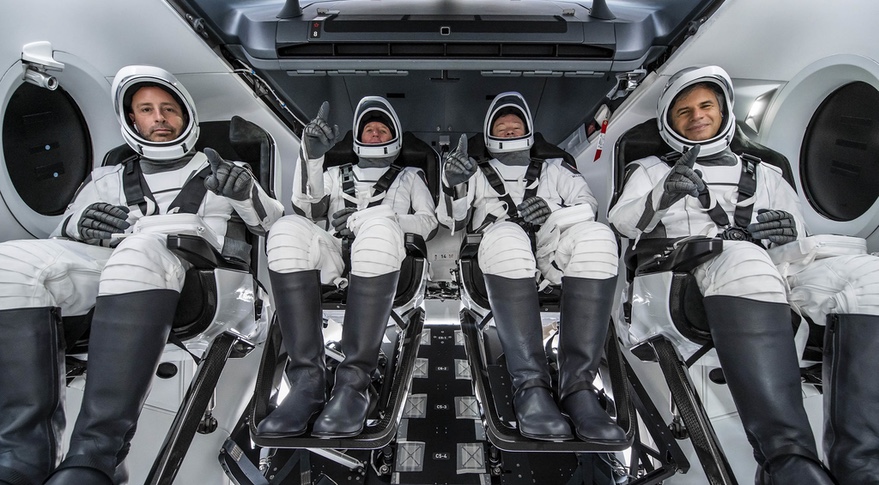WASHINGTON — The first private mission to the International Space Station by an American vehicle is scheduled to launch this week to serve as a first step in one company’s plans to establish a commercial space station.
Axiom Space is targeting April 6 for the launch of its Ax-1 mission on a SpaceX Crew Dragon spacecraft from the Kennedy Space Center, with a static-fire test of the Falcon 9 rocket scheduled for April 4. That Crew Dragon spacecraft, Endeavour, will spend 10 days in space, including eight docked to the ISS. There are additional launch opportunities daily through at least April 9.
Endeavour will be commanded by Michael López-Alegría, an Axiom employee and former NASA astronaut who spent six months on the ISS in 2006–2007. The other three are Axiom customers: Larry Connor, Mark Pathy and Eytan Stibbe.
Preparations for the mission, delayed from late February first by spacecraft readiness and then to avoid conflicts with the Space Launch System’s wet dress rehearsal at KSC, are going well, the Ax-1 crew and company officials said at an April 1 briefing. “I can say with zero hesitation that we are ready to fly,” said López-Alegría.
At both this briefing and during previous events, the company and its customers have gone to great lengths to emphasize that they do not consider themselves tourists. All four plan to carry out a range of experiments and investigations for organizations in Canada, Israel and the United States.
“I think it’s important to address the difference between space tourists and private astronauts,” said Connor, who will also be the pilot of the spacecraft. Space tourists, he argued, will get 10 to 15 hours of training for 5 to 10 minutes in space, an apparent reference to suborbital vehicles operated by Blue Origin and Virgin Galactic.
He considered the Ax-1 crew private astronauts. “In our case, depending on our role, we’ve spent anywhere from 750 to over 1,000 hours training,” he said. “Additionally, across all of the astronauts here, we’re going to do some 25 different experiments encompassing 100 hours of research on the eight days we’re on the ISS.”
The Ax-1 crew will primarily live and work in what’s known as the U.S. Operational Segment of the station, which includes NASA, European and Japanese modules. Michael Suffredini, president and chief executive of Axiom Space and a former NASA ISS program manager, said crew will be able to visit the Russian segment “by invitation” from Roscosmos cosmonauts.
The mission is a major milestone for Axiom Space, which is preparing to fly a series of missions like Ax-1 to the ISS before installing a commercial module there as soon as 2024. That module, and others added to it, will allow the company to have a larger, potentially permanent, presence on the ISS, and serve as the core for a stand-alone commercial space station when the ISS is retired.
“What’s unique about this mission is that it’s complete funded commercially,” Suffredini said. Axiom will compensate NASA for use of ISS resources but will also be paid by NASA for providing services, such as returning equipment and experiments on the Crew Dragon.
Axiom, though, has provided few financial details about the mission, such as the price paid by its three customers, rumored to be approximately $55 million each. Suffredini declined to say if the Ax-1 mission was profitable for Axiom Space.
“We’re a commercial entity. Our objective is to make money over the life of the company, or we’re not much of a company,” he said. “Suffice it to say, this is in line with what our original vision for the mission was.”
“Ultimately, these will grow to a point where, when we’re flying to our own space station, we’ll have quite a bit more access,” he continued. “We’ll evolve these flights to do more and more commercial research work, leading on to manufacturing in space.”
Axiom will follow Ax-1 with Ax-2, slated for launch in early 2023 and commanded by former NASA astronaut Peggy Whitson. Axiom has named one customer, John Shoffner, who will be the pilot of the vehicle, but has not identified who else will go on the mission. The company has an agreement with SpaceX for two additional Crew Dragon missions to the ISS. By Ax-4, Suffredini said, Axiom expects to fly four customers on the mission without a professional astronaut as commander.
All four Ax-1 crew members said they were looking forward to carrying out research on the station. “I hope to be successful in highlighting the value and importance and sheer amount of Canadian research that is available,” said Pathy, a Canadian entrepreneur. “I’m happy to provide that opportunity.”
It will not be all work, though. Stibbe noted the delay in the launch means that they will be on the ISS for Passover. He said he was looking forward to celebrating the holiday on the station, but with some changes in tradition, such as drinking wine. “I took a wine glass with me, but I don’t think I will find any wine in the station, and I don’t think I need a glass to drink wine.”
